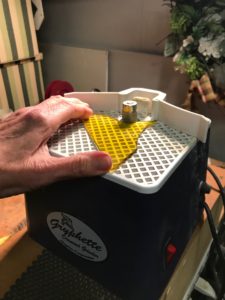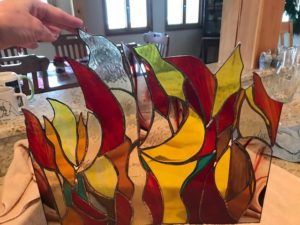

Those who have walked through the doors of Bedford Landings B&B know that there are several large stained glass pieces hanging or installed as windows.
I (Karen) took a stained glass at a community college in 1977. Although I enjoyed it, I could not afford all of the tools at that time so I did not pursue this hobby. It was 29 years later that Jack gave me a stained glass kit for Christmas. Along with a refresher lesson, a diamond cutter, pliers, a glass grinder, and a pattern to make an iris, he enabled me to start again making glass pieces. The purple iris (in this photo) is the first one I made when I started with my refresher course.
I enjoy working with glass and by no means do I feel that I am an artistic master, but it is a relaxing hobby. By and large I give them away as gifts or use them for decorating.
Many who drool over the beauty of any stained glass piece wonder why purchasing a piece is so costly. That’s why I wanted to share the process with you so you could understand.
I recently have embarked upon a project I just call “fire.“ Generally in the winter we have a nice warm fire burning in our fireplace.
But in the summer, of course we don’t build a fire. I have been setting large white candles inside the fireplace to light for the romantic glow everyone wants to enjoy when they visit a bed-and-breakfast. But the candles burn down and look ragged, sometimes soot from the chimney falls on them during the summer and I just haven’t been satisfied with that “look.“
That’s why I decided to do a large stained glass piece to put inside the fireplace in the summer, instead. The first step in stained glass work is to find or make a pattern the size of the glass that you want to prepare. The second step is my favorite part; selecting from the array of colors and textures of glass to complete your piece. Glass is rather expensive. Red glass is the most expensive as it often has flecks of gold in it.
For my fire piece I designed the pattern and used many of the scrap pieces of glass that I already had in my inventory. I did have to purchase a couple of new large pieces.
You need two patterns; one pattern is trimmed to glue to the glass and used to cut each piece of glass, much like making a garment in sewing. Glass cutting is done with a diamond head hand cutter.
The second pattern is used to lay the cut pieces on the pattern to begin to puzzle the glass pieces together. This photo shows the (pink) diamond cutter and the breaking pliers with just a few pieces of the cut glass laid on the pattern.
 Once all of the pieces are cut and laid together, the next process is grinding. Each individual piece must be ground smooth so that there are no sharp edges and each piece fits snugly against its neighbor. This is done with an electric grinder and wearing goggles is a must to protect your eyes.
Once all of the pieces are cut and laid together, the next process is grinding. Each individual piece must be ground smooth so that there are no sharp edges and each piece fits snugly against its neighbor. This is done with an electric grinder and wearing goggles is a must to protect your eyes.
The next step involves foiling each piece of glass. Copper foil with a sticky back is used to rim around each piece of glass. The foiled pieces are again laid down on the pattern flat. Copper is a heat conductor and will help the glass pieces fuse together once solder is applied.
Once all of the pieces are foiled the next step is using a compound called flux to interact with the copper and the solder. One whole side of the entire design is tacked with solder at key intersection points. Then the entire piece is flipped and totally soldered on the back. Flux is used each time. The combination of flux, copper as a heat conductor, and the hot solder (tin and lead mix) bind glass pieces together.
 Once the piece is fully soldered front and back, it’s time to clean the entire glass. Be sure the glass is fully cooled, otherwise it may crack. In addition be really careful while handing it as it can be somewhat fragile if it is large and not yet framed. Using simple baking soda and water with a soft cloth or a mild watered down detergent works well.
Once the piece is fully soldered front and back, it’s time to clean the entire glass. Be sure the glass is fully cooled, otherwise it may crack. In addition be really careful while handing it as it can be somewhat fragile if it is large and not yet framed. Using simple baking soda and water with a soft cloth or a mild watered down detergent works well.
One of the last steps is to put patina over the whole glass. As lead tends to turn black anyway, many people who do stained glass select a black patina. There’s also the option to use a copper patina.
Now it is time to determine what frame will encase the entire piece. Because I want to use this to stand up as if it is a fire in the fireplace, I wanted a large rustic looking frame. That’s when I called on Jack to design the frame to hold a piece entirely. He constructed the frame and I painted it black.
It is still winter and we are still building fires but I wanted to see how this would look for the summer fireplace. It looks like I need more LED candles but I think it will be a good addition.
There are about 40 pieces of glass in this piece. Each one had to be cut, ground, foiled, and soldered before the entire piece was painted with patina and cleaned. I would guess I have about 25 hours in this project and $80 in supplies. It would cost well over $100 to purchase such a piece but hopefully seeing the many processes provides not only an explanation but an appreciation of what goes into a stained glass piece. Can’t wait for Spring so we can place this inside the fireplace!
Beautiful. Always admired stained glass but no idea the detailed process. Keep up the beautiful works.
A perfect fireplace insert! Lovely warm glowing fire -- very artistic. Can hardly wait to see your creation.
I am fortunate enough to own three DeBord stained glass originals. Her skill has improved and refined over time. It is worth a visit to Bedford Landings just to study her work!